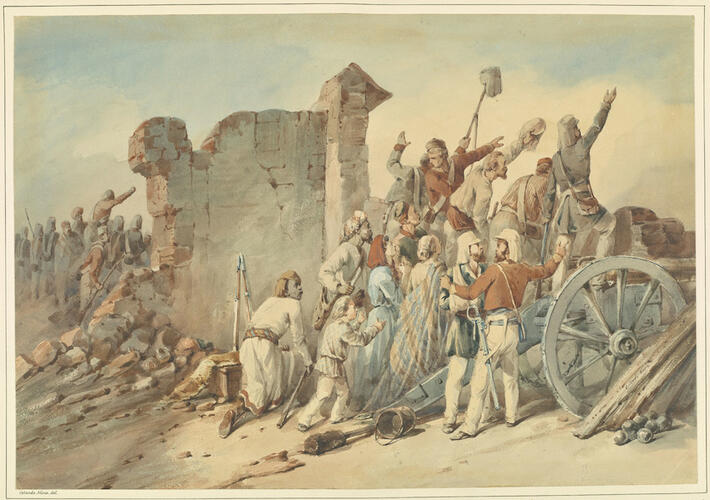-
1 of 253523 objects
The Indian Rebellion: The Relief of Lucknow, 21st March 1858 c.1858
Watercolour | 33.5 x 47.8 cm (whole object) | RCIN 990620

Orlando Norie (1832-1901)
The Indian Rebellion: The Relief of Lucknow, 21st March 1858 c.1858
-
A watercolour showing a scene from the relief of Lucknow. British soldiers and civilians alongside Indian allies are grouped at the walls of a ruined building, perhaps intended as the British Residency. They wave and signal, probably to a column of East India Company soldiers sent to break the siege. Signed. Inscribed on the verso: General Havelock's Relief of Lucknow.
Oudh [Awadh], a princely state in the north east of India, was annexed by the British in 1856. Its capital, Lucknow, and in particular the British residency, was the site of fierce fighting between British regiments and Indian sepoys assisted by other Indian combatants, during the Indian Rebellion. A relief column under the command of Sir Henry Havelock was sent to break the siege, but was forced to join the garrison. In October 1857 a larger force was able to relieve the garrison. The last of the rebels left Lucknow on 21st March, 1858.
The Indian Rebellion, or the First War of Independence (commonly known as the Indian Mutiny) was sparked in May 1857 by an incident among angered Indian soldiers serving the British East India Company stationed at Meerut. It was soon joined by Bengal Infantry regiments and civilians, spreading across north and north east India to include the cities of Delhi, Agra, Kanpur and Lucknow. Simmering resentment at colonial rule formed the backdrop to the Rebellion. The British East India Company's annexation of lands, crippling taxation and religious intolerance were among the many causes.
Orlando Norie was born into a well-known Scottish artistic family but spent much of his working life in France. He is particularly known as a painter of military scenes, and had a long-lasting professional relationship with the printsellers and publishers Ackermann & Co who managed his picture sales and published lithographs after his drawings, beginning with scenes of the Crimean War in the 1850s. He is not thought to have travelled outside of Europe, and therefore his depictions of colonial military action are not personal eye-witness accounts. The significant group (c.70) of watercolours by Norie now in the Royal Collection primarily came from two sources - Queen Victoria, via purchase or commission, and at least eighteen which were previously in the collection of her son Prince Arthur, Duke of Connaught, who served in the British Army. These were given to the Royal Collection after his death in 1942.
Provenance
RCINs 990618, 990619, 990620 may be the watercolours acquired by Queen Victoria on 6 December, 1858, for £7.17s. 6d.
-
Creator(s)
Acquirer(s)
-
Medium and techniques
Watercolour
Measurements
33.5 x 47.8 cm (whole object)
Other number(s)
RL O : Royal Library "O" Number Register – RL O0620